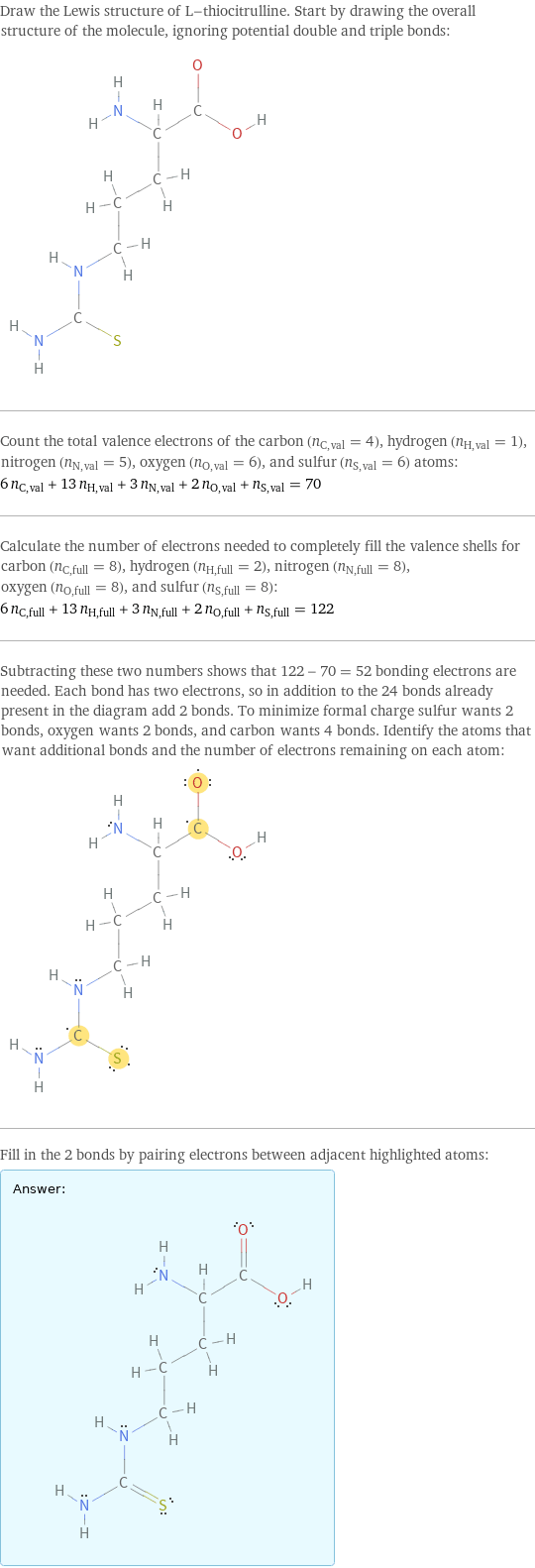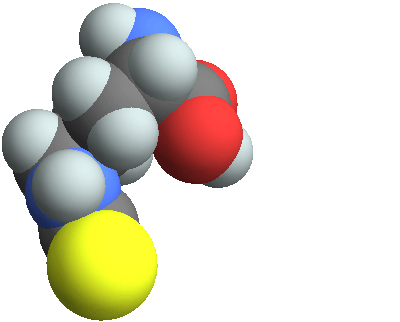Input interpretation

L-thiocitrulline
Chemical names and formulas

formula | C_6H_13N_3O_2S name | L-thiocitrulline IUPAC name | (2S)-2-amino-5-(carbamothioylamino)pentanoic acid mass fractions | C (carbon) 37.7% | H (hydrogen) 6.85% | N (nitrogen) 22% | O (oxygen) 16.7% | S (sulfur) 16.8%
Lewis structure

Draw the Lewis structure of L-thiocitrulline. Start by drawing the overall structure of the molecule, ignoring potential double and triple bonds: Count the total valence electrons of the carbon (n_C, val = 4), hydrogen (n_H, val = 1), nitrogen (n_N, val = 5), oxygen (n_O, val = 6), and sulfur (n_S, val = 6) atoms: 6 n_C, val + 13 n_H, val + 3 n_N, val + 2 n_O, val + n_S, val = 70 Calculate the number of electrons needed to completely fill the valence shells for carbon (n_C, full = 8), hydrogen (n_H, full = 2), nitrogen (n_N, full = 8), oxygen (n_O, full = 8), and sulfur (n_S, full = 8): 6 n_C, full + 13 n_H, full + 3 n_N, full + 2 n_O, full + n_S, full = 122 Subtracting these two numbers shows that 122 - 70 = 52 bonding electrons are needed. Each bond has two electrons, so in addition to the 24 bonds already present in the diagram add 2 bonds. To minimize formal charge sulfur wants 2 bonds, oxygen wants 2 bonds, and carbon wants 4 bonds. Identify the atoms that want additional bonds and the number of electrons remaining on each atom: Fill in the 2 bonds by pairing electrons between adjacent highlighted atoms: Answer: | |
3D structure

3D structure
Basic properties

molar mass | 191.25 g/mol phase | solid (at STP)
Units

Hydrophobicity and permeability properties

predicted LogP hydrophobicity | -2.07 predicted LogS | -1.98
Basic drug properties

approval status | experimental | small molecule
Chemical identifiers

PubChem CID number | 2733514 PubChem SID number | 7890409 SMILES identifier | C(CC(C(=O)O)N)CNC(=S)N InChI identifier | InChI=1/C6H13N3O2S/c7-4(5(10)11)2-1-3-9-6(8)12/h4H, 1-3, 7H2, (H, 10, 11)(H3, 8, 9, 12)/f/h10, 12H, 8H2/b9-6+ InChI key | BKGWACHYAMTLAF-LWDWWYSFDQ